Several weeks ago, a mid-60’s male came to the clinic presenting with an AC Joint separation after falling from his mountain bike (that’s what we get for trying to take advantage of the mild Michigan winter!) This patient is very active; he regularly participates in a men’s competitive soccer league and mountain biking. After suffering the injury and experiencing signs and symptoms of pain, decreased range of motion (ROM), and weakness of the shoulder, the patient assumed surgery was his only option.
Prior to beginning therapy, the patient had consults with three different orthopedic surgeons, all of whom recommended physical therapy as an initial treatment. Upon meeting him, hearing how he injured his shoulder and the activities he wants to return to, I knew his personality type as one to push through the pain when exercising.
I asked the patient what, if anything, he has been doing at home after the injury—either to decrease pain or improve function. He mentioned that he would attempt to apply an aggressive cranially directed force to the shoulder in an attempt to correct his step deformity that was present after injury. He made a point to mention how much he visually disliked the look of the step deformity that was present after injury! When I looked at his shoulder and the amount of vertical displacement present, I presumed hat he had a grade 3 separation at minimum.
“Did that help?” I asked.
“Ehh…I’m not too sure, but it does push it back up and makes it look nicer”
Physical therapy treatment always includes education on injury prevention. I told him that what he was doing to fix his step deformity was a major no-no. In fact, what he was doing would likely make things worse over time. We discussed how the bony surfaces of the AC joint surfaces are sloped in nature of articulation, which makes the joint more inherently susceptible to dislocation. When the force applied to the region exceeds the tensile strength of the ligaments, further injury can occur. Although the coracoclavicular ligament was likely already completely torn, it didn’t seem like a good idea to repeatedly perform a maneuver that leads to further AC joint pathology as a means of treatment.
We also got to talking about exercise—what he enjoyed doing, what he was able to do pain-free, and what exercises were being performed when painful. I provided him with feedback on the exercises and described how we would create a treatment plan that would safely strengthen his shoulder with respect to the severity and limitations of his injury prior to the follow up appointment with his surgeon. Here are 5 exercises that I instructed him to avoid initially.
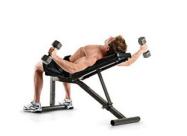 1) Pectoral flys: When AC joint pathology is suspected, PTs perform a horizontal adduction test in order to provoke symptoms. Pain when moving the arm across the body (horizontal adduction) is indicative of a positive test. The pec fly exercise replicates the horizontal adduction test and should be avoided to prevent further damage.
1) Pectoral flys: When AC joint pathology is suspected, PTs perform a horizontal adduction test in order to provoke symptoms. Pain when moving the arm across the body (horizontal adduction) is indicative of a positive test. The pec fly exercise replicates the horizontal adduction test and should be avoided to prevent further damage.
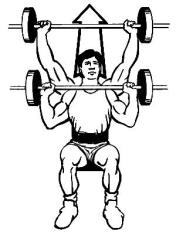 2) Overhead press: The closed pack position of a joint is the the point at which the joint surfaces are maximally congruent, and the ligaments are most pulled taut (i.e. less space in the joint for smooth movement). The closed pack position for the AC joint is 90 degrees of shoulder abduction. The closed pack position of the glenohumeral (GH) joint is 90 degrees abduction and external rotation, or maximum abduction and external rotation depending on the source. Overhead press can lead to shearing between the lateral end of the clavicle and the medial aspect of the acromion. It also takes the shoulder through ranges of the closed pack position repeatedly. We also know that the articular disc of the AC joint is already susceptible to age related degenerative changes which can lead to AC joint arthrosis, even without a pre-existing injury.
2) Overhead press: The closed pack position of a joint is the the point at which the joint surfaces are maximally congruent, and the ligaments are most pulled taut (i.e. less space in the joint for smooth movement). The closed pack position for the AC joint is 90 degrees of shoulder abduction. The closed pack position of the glenohumeral (GH) joint is 90 degrees abduction and external rotation, or maximum abduction and external rotation depending on the source. Overhead press can lead to shearing between the lateral end of the clavicle and the medial aspect of the acromion. It also takes the shoulder through ranges of the closed pack position repeatedly. We also know that the articular disc of the AC joint is already susceptible to age related degenerative changes which can lead to AC joint arthrosis, even without a pre-existing injury.
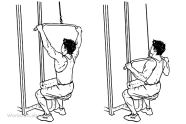
3) Lateral pull-downs: This exercise requires starting with the arms outstretched in an overhead position and moves downward to the sternum. As mentioned above, this movement goes through the closed pack position of both the AC and GH joint and also creates repeated shearing of the AC joint.
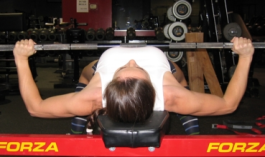
4) Wide-grip bench press: It seems to be one of the primary complaints of people with AC joint injury. Pain when performing this exercise occurs for the same reasons listed above. Mechanically, it puts an unfavorable amount of stress and impact to the injured AC joint.
5) Tricep Dips: Tr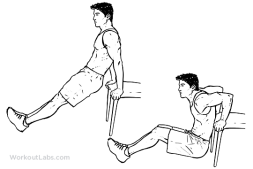 icep dips apply additional, unwanted pressure to the anterior capsule of the shoulder. This can lead to anterior instability and laxity of the anterior capsule, which is the most common direction of instability of the shoulder. During the triceps dip, similar forces occur as with the example given above when my patient was trying to push his arm up to make the step deformity look better. There are safer ways to strengthen!
icep dips apply additional, unwanted pressure to the anterior capsule of the shoulder. This can lead to anterior instability and laxity of the anterior capsule, which is the most common direction of instability of the shoulder. During the triceps dip, similar forces occur as with the example given above when my patient was trying to push his arm up to make the step deformity look better. There are safer ways to strengthen!

